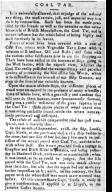[ Coal Tar ]
Date: 1789/11/24
Source:
Royal Gazette and the Nova Scotia Advertiser.
Institution: Nova Scotia Archives
| Source Origin: Nova Scotia Newspapers on Microfilm
| Reference: Consult the Nova Scotia Archives' "Nova Scotia Newspapers on Microfilm" list (Royal Gazette) for a complete account of microfilm reels for this paper. EMMR includes recipes from Microfilm Reels 8162, 8163, 8165, and 8167.
An detailed explanation championing coal tar over other applications used to protect ship bottoms from sea worm damage. Vol. 1, No. 35. Microfilm Reel 8162.
COAL TAR.
____
It is universally allowed, that to judge of the value of
any thing, the most certain, just, and impartial way is to
do it by comparison. Such has been the mode prac-
tised by the friends as well as the enemies to that valua-
ble article of British Manufacture, the Coal Tar, and in
no one instance has the result failed of being highly and
most decisively in its favour.
Pieces of wood have been covered with a coat of
Coal Tar, others with Vegetable Tar; some with a
mixture of Brimstone, Oil and Rosin; and some with
the various other substances now in use for shipping--
These have been nailed to the bottoms of ships going to
the West Indies, with the express view, whether the
Coal Tar really possessed the extraordinary and peculiar
quality of preventing the bite of the Sea Worm, which
is so destructive to the interest of our Ship Owners, and
even to the lives of our valuable Seamen.
Upon the return of those ships, the different pieces of
wood were examined in the presence of many witnesses;
some of whom have, with a generosity and candour that
will ever do them honour, come spontaneously forward,
and given a public testimony of the great superiority of
the Coal Tar: those pieces pieces of wood payed with
it remaining perfectly sound, while the others were en-
tirely perforated and destroyed.
The result of another comparative trial has just tran-
spired, and is literally thus:
In the month of September, 1788, the ship, Louisa,
Capt. Steele, at the particular desire of a ship-builder in
the river, had one side of her bottom (then much in pos-
session of the worm) payed with Coal Tar, and the other
with white stuff. She is now returned from a voyage to
Kingston and Black River in Jamaica, and being yester-
day in Shadwell Dock, underwent an examination; when
it was found, as far as could be judged, that the side
payed with the Coal Tar, was not only much cleaner
than the other, but also that the worm had not made any
farther impression on it; while, on the contrary, the side
payed with the white stuff was much more wormed than
before. Of this circumstance Capt. Steele is ready to
give a confirmation, if applied to at Lloyd’s, or the
Jamaica Coffee houses.
Download: Transcription | Images
